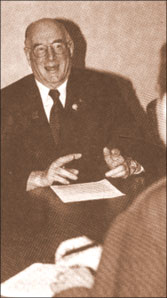

| December 2003 Quick Links: |
 Barry Thompson discusses key membership development issues facing Rotary in its second century As Rotary’s membership number shows encouraging increases, the 2003-04 Membership Development and Retention Committee is working to ensure that steady growth continues in the future. The committee’s chairman is Barry Thompson, a member of the Rotary Club of Padstow, Australia, since 1978. A past RI director who served as treasurer in 1997-98, Thompson served on the Membership Development Task Force in 1994-95 and was vice chairman of the Membership Development and Retention Committee in 2002-03. Thompson met with editors of THE ROTARIAN to explain how the committee intends to approach issues such as retention, diversity, and extension to keep Rotary going.
Barry Thompson discusses key membership development issues facing Rotary in its second century As Rotary’s membership number shows encouraging increases, the 2003-04 Membership Development and Retention Committee is working to ensure that steady growth continues in the future. The committee’s chairman is Barry Thompson, a member of the Rotary Club of Padstow, Australia, since 1978. A past RI director who served as treasurer in 1997-98, Thompson served on the Membership Development Task Force in 1994-95 and was vice chairman of the Membership Development and Retention Committee in 2002-03. Thompson met with editors of THE ROTARIAN to explain how the committee intends to approach issues such as retention, diversity, and extension to keep Rotary going.Q: Membership saw a slight decline in 2002-03. What can be done to reverse that trend?
A: History shows that after a successful period of membership growth we tend to suffer a decline. That occurred early in 2002-03, but subsequent months showed a continual increase based on the lower of July starting figures. In fact, 27 of our 34 zones showed an increase on that basis with only seven zones showing a loss of membership. Over all zones, there was an average increase of 1.5 percents, with the largest increase in Zone 10 of 11.1 percent. On the other hand, the poorest performance was a loss in Zone 20 of 5.4 percent. All Rotarians associated with the membership effort are working hard to ensure that, this year and in the future, our association will continue to return positive growth.
Q: What encouraging trends do you see?
A: As I noted, 27 of our 34 zones recorded an increase in membership in
2002-03 after adjusting the starting figures for the decline expected at the end of 2001-02. Perhaps even more encouraging to me was the enthusiasm shown by RIMCs (Rotary International membership coordinators) during their training for their 2003-04 duties. These dedicated Rotarians clearly believe in their task and in its ultimate success. Similarly, I am extremely encouraged by the dedication of RI Membership Development staff in Evanston, who work hard to assist all of us in achieving our membership goals.
Q: Describe the mission of the Membership Development and Retention Committee and how it helps clubs and districts.
A: The RI Code of Policies states: “This committee should provide support and advice to governors in promoting membership development and education in their districts. It will serve as a resource to districts and clubs in developing programs to recruit new members, and explore opportunities for the formulation of new Rotary Clubs.” The committee consists of 13 members from 10 countries who are dedicated to the growth of our association. Last year and this year, the committee has been focused on obtaining information in various regions and identifying trends within these regions because to some extent, Rotary is influenced by the culture, economics, and issues evident within a region. Additionally, the New Generations Subcommittee of the Membership Development and Retention Committee has 10 members, three of whom are also members of the Membership Development and Retention Committee. That subcommittee also has the task of providing support and advise to the governors in promoting diversity in membership development and education in their district.